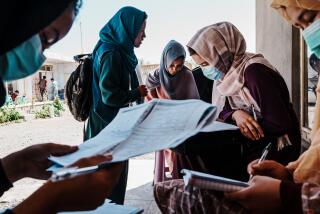2011 seen as make-or-break year for Afghan mission
- Share via
Reporting from Kabul, Afghanistan — A U.S. troop buildup in 2010 was meant to blunt the momentum of the Taliban insurgency in Afghanistan. Now it is 2011 that has become the make-or-break year.
U.S. and NATO officials have sought to put a positive face on the last 12 months of fighting here, citing significant military gains in the Taliban’s southern heartland, a concerted campaign of strikes targeting the insurgents’ midlevel field command and the growth of the NATO force to levels at last deemed adequate for the task at hand.
“We are convinced … that we are actually making progress; we have proven that progress is possible,” German Brig. Gen. Josef Blotz, a spokesman for NATO’s International Security Assistance Force, told journalists in Kabul in December. “We will keep up the pressure on the insurgency.”
But some ominous developments, both on and off the battlefield, bode ill for the new year.
The Taliban made deep inroads in swaths of the country previously regarded as relatively safe — the north, northwest and center — eroding confidence in the West’s ability to protect the Afghan populace and hampering aid and reconstruction efforts. Parliamentary elections in September intended as a democratic showpiece devolved into fraud and chaos. Corruption tightened its grip on the government of President Hamid Karzai.
By midsummer, combat casualties among U.S. troops and the North Atlantic Treaty Organization force as a whole had already reached their highest annual levels of the war. On Friday, the American military toll stood just short of a grim milestone: 498 deaths, according to the independent website icasualties.org, more than in the previous two years put together.
Altogether, Western troops suffered more than 700 fatalities in 2010, heightening unease on the part of European governments keenly aware of the war’s unpopularity at home. While the NATO allies presented a united front at a conference in November, the Americans — whose troops make up two-thirds of the 150,000-member Western force — privately fretted about the likelihood of the United States shouldering an even larger share of the military burden in coming years.
As violence burgeoned, civilian casualties did too, jumping by 20% in the first 10 months of 2010 compared with the same period in the previous year, according to the United Nations. Most of the 2,412 noncombatant deaths in that period were attributed to the Taliban. But many Afghans, to the frustration of Western military officials, tend to place the overall blame on Western forces, seeing their presence as a magnet for insurgent attacks that kill and injure civilians.
With both the Taliban and the West promising to intensify their military actions in months ahead, civilians will continue to take the brunt of suicide attacks and roadside bombings that haunt daily life in many parts of the country, officials have said. On Friday, local officials near Kandahar reported that insurgents threw hand grenades into two homes in a still-unexplained attack that killed a child and wounded six other people.
“Sometimes we feel there is simply nowhere safe for us,” said Samira Khan, a teacher in Kandahar province, a focal point of the fighting. “We keep waiting for life to get better, but it always seems we have to wait some more.”
At the outset of 2010, Kandahar was declared a testing ground for the U.S.-led military push in the south. After months of delays, Western forces did manage to drive the Taliban out of key districts surrounding Kandahar city, which the movement regards as its spiritual home.
But the offensive did not begin in earnest until late summer, postponed in part after U.S. officials recognized the difficulties of bringing security and governance to the much smaller town of Marja, in neighboring Helmand province, the scene of an earlier campaign led by U.S. Marines. In the interim, the Taliban sowed terror in Kandahar by assassinating people affiliated with the government or with foreign forces.
The durability of gains touted in Kandahar province will probably not be apparent until springtime, Western commanders have acknowledged. Much depends on whether the insurgents are able to regroup and rearm over the winter in their traditional sanctuaries in Pakistan, which remain beyond the reach of NATO ground forces.
The insurgents’ havens in Pakistan’s tribal areas became somewhat less safe with a dramatic increase in strikes by U.S. aerial drones over the last year. But President Obama’s year-end war review, issued almost exactly 12 months after he ordered the 30,000-troop buildup, was sharply critical of Pakistan’s inaction against militants sheltering on its soil.
U.S. officials still publicly insist that the July 2011 target for the start of a troop drawdown from Afghanistan has not been abandoned. But a new date, 2014, has come to the fore. That is when it is hoped that Afghan security forces will be ready to take the lead in safeguarding the country.
Although intensive recruitment efforts have swelled the Afghan police and army to a quarter of a million, their Western trainers must grapple with an array of problems in the ranks: drug abuse, illiteracy, ethnic tensions and the occasional violent and unexpected display of loyalty to the Taliban.
Even Western officials who describe an improving picture in Afghanistan, such as Staffan de Mistura, the head of the U.N. mission here, acknowledge that the coming year is likely to be a difficult one.
“Our assessment,” he told the Nations Security Council last week, “is before it gets better, it may get worse.”
More to Read
Sign up for Essential California
The most important California stories and recommendations in your inbox every morning.
You may occasionally receive promotional content from the Los Angeles Times.










